Macroeconomics Assignment: Monetary Policies & Global Crisis in China
VerifiedAdded on 2020/04/29
|5
|765
|94
Homework Assignment
AI Summary
This macroeconomics assignment examines two key monetary policies implemented in China: tightening monetary policy through raising money market rates and adjusting reserve requirements. The assignment explains how the People's Bank of China has utilized these tools to manage credit growth, support the Yuan, and maintain financial stability. It also analyzes the effects of the global financial crisis on China, detailing the collapse of the stock market, declines in FDI, and reduced export growth. The assignment references several economic texts to support its findings, providing a comprehensive overview of China's economic responses to global financial pressures. The assignment provides a concise overview of China's approach to economic management in the face of global challenges.
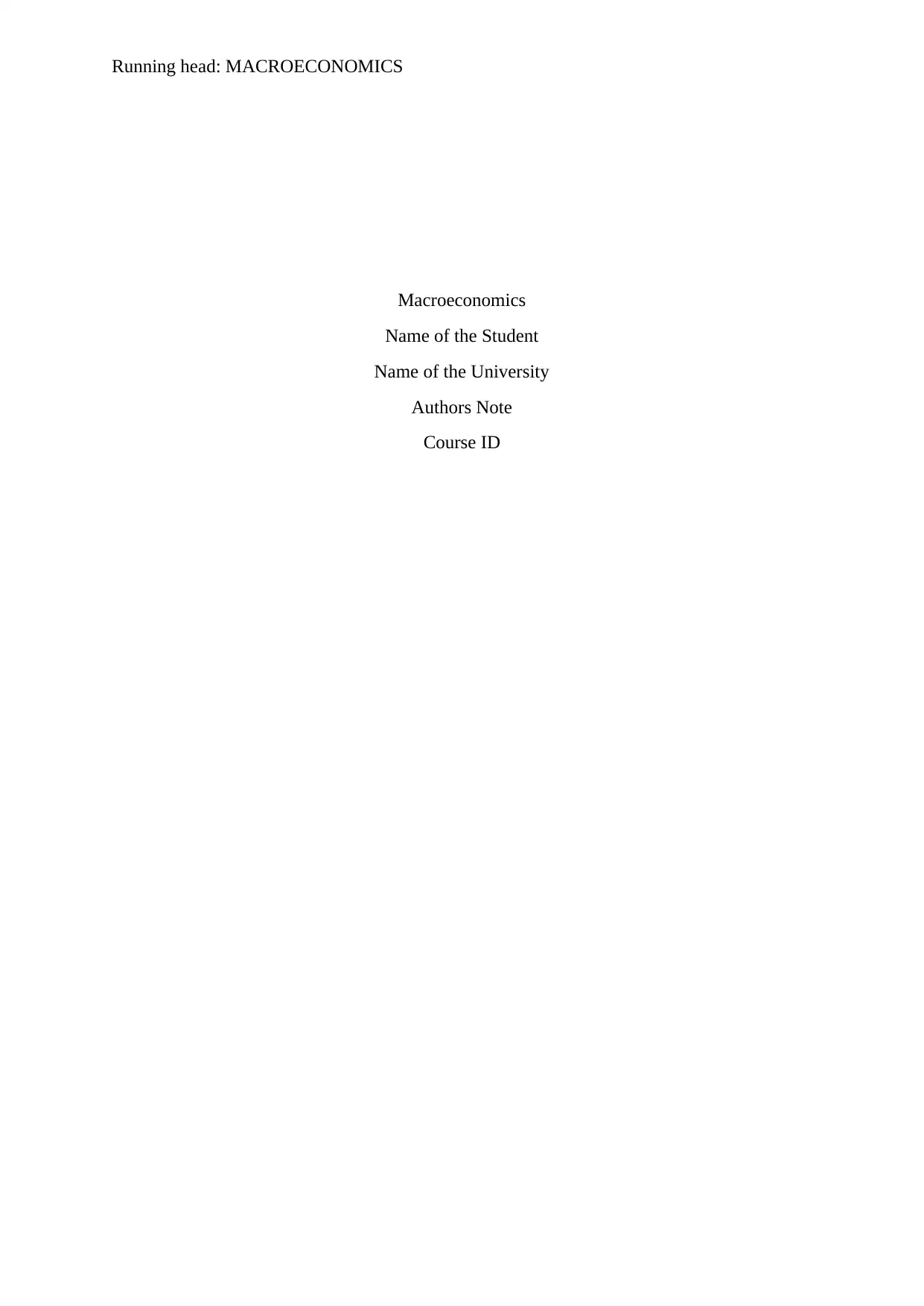
Running head: MACROECONOMICS
Macroeconomics
Name of the Student
Name of the University
Authors Note
Course ID
Macroeconomics
Name of the Student
Name of the University
Authors Note
Course ID
Paraphrase This Document
Need a fresh take? Get an instant paraphrase of this document with our AI Paraphraser
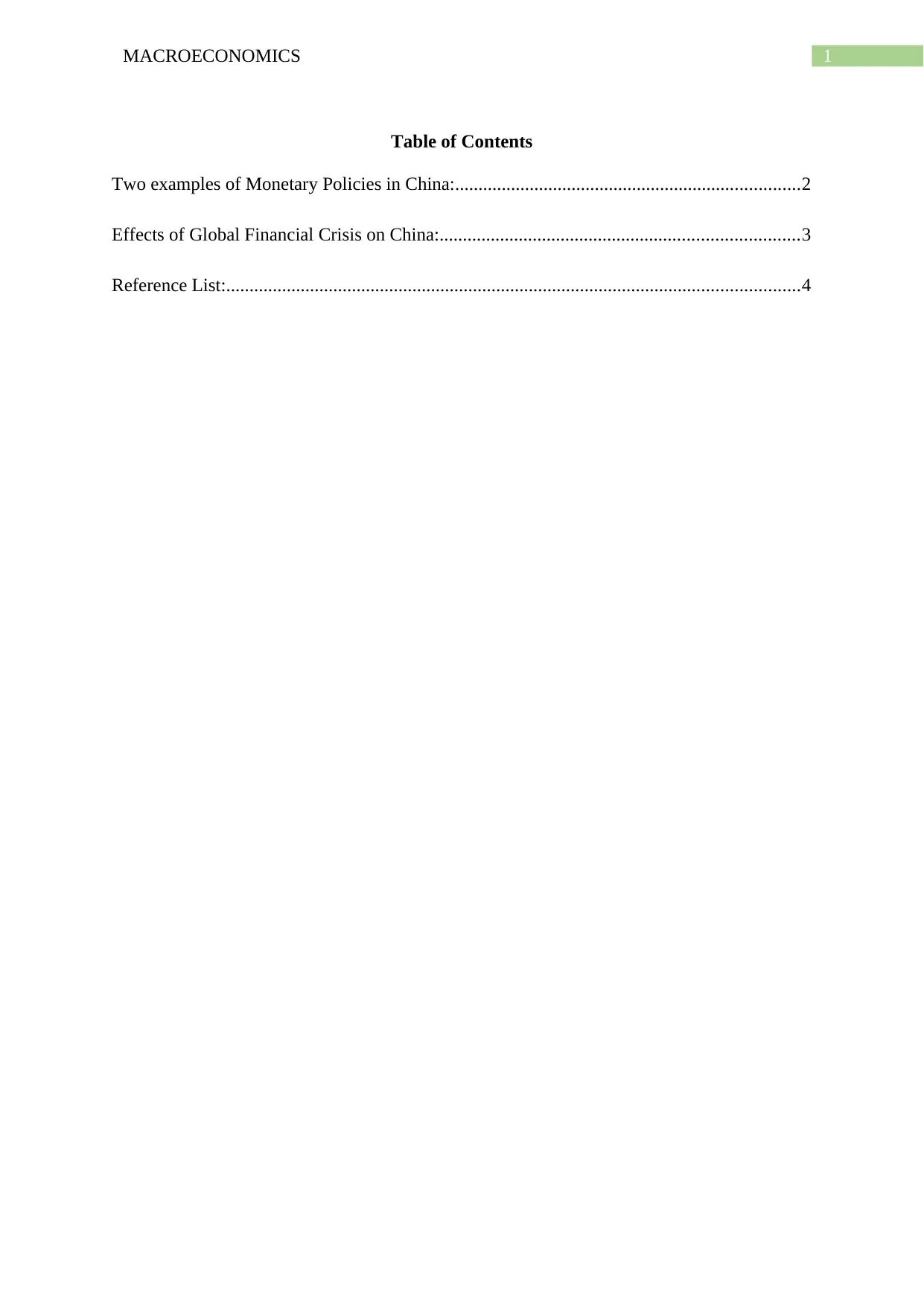
1MACROECONOMICS
Table of Contents
Two examples of Monetary Policies in China:..........................................................................2
Effects of Global Financial Crisis on China:.............................................................................3
Reference List:...........................................................................................................................4
Table of Contents
Two examples of Monetary Policies in China:..........................................................................2
Effects of Global Financial Crisis on China:.............................................................................3
Reference List:...........................................................................................................................4
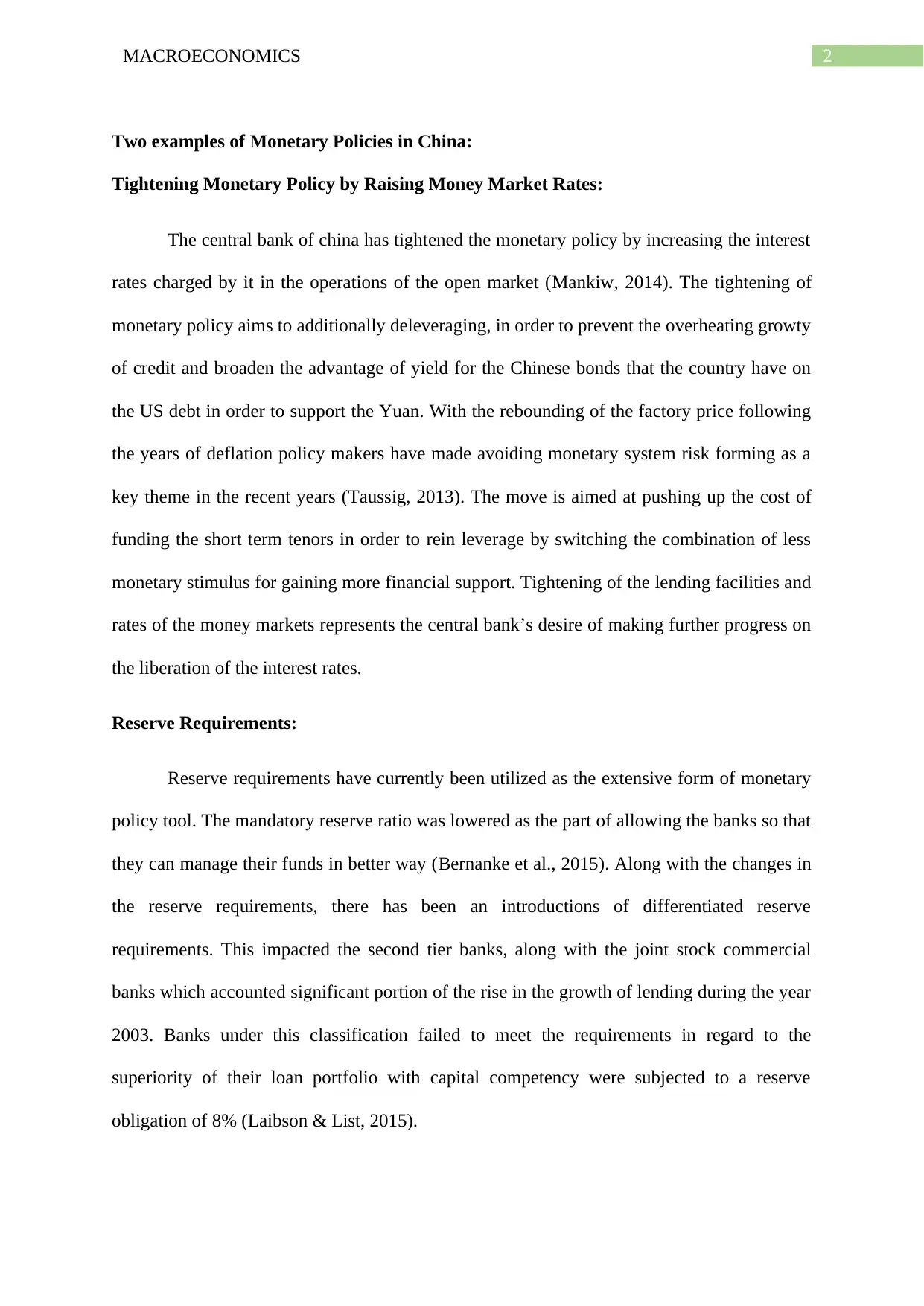
2MACROECONOMICS
Two examples of Monetary Policies in China:
Tightening Monetary Policy by Raising Money Market Rates:
The central bank of china has tightened the monetary policy by increasing the interest
rates charged by it in the operations of the open market (Mankiw, 2014). The tightening of
monetary policy aims to additionally deleveraging, in order to prevent the overheating growty
of credit and broaden the advantage of yield for the Chinese bonds that the country have on
the US debt in order to support the Yuan. With the rebounding of the factory price following
the years of deflation policy makers have made avoiding monetary system risk forming as a
key theme in the recent years (Taussig, 2013). The move is aimed at pushing up the cost of
funding the short term tenors in order to rein leverage by switching the combination of less
monetary stimulus for gaining more financial support. Tightening of the lending facilities and
rates of the money markets represents the central bank’s desire of making further progress on
the liberation of the interest rates.
Reserve Requirements:
Reserve requirements have currently been utilized as the extensive form of monetary
policy tool. The mandatory reserve ratio was lowered as the part of allowing the banks so that
they can manage their funds in better way (Bernanke et al., 2015). Along with the changes in
the reserve requirements, there has been an introductions of differentiated reserve
requirements. This impacted the second tier banks, along with the joint stock commercial
banks which accounted significant portion of the rise in the growth of lending during the year
2003. Banks under this classification failed to meet the requirements in regard to the
superiority of their loan portfolio with capital competency were subjected to a reserve
obligation of 8% (Laibson & List, 2015).
Two examples of Monetary Policies in China:
Tightening Monetary Policy by Raising Money Market Rates:
The central bank of china has tightened the monetary policy by increasing the interest
rates charged by it in the operations of the open market (Mankiw, 2014). The tightening of
monetary policy aims to additionally deleveraging, in order to prevent the overheating growty
of credit and broaden the advantage of yield for the Chinese bonds that the country have on
the US debt in order to support the Yuan. With the rebounding of the factory price following
the years of deflation policy makers have made avoiding monetary system risk forming as a
key theme in the recent years (Taussig, 2013). The move is aimed at pushing up the cost of
funding the short term tenors in order to rein leverage by switching the combination of less
monetary stimulus for gaining more financial support. Tightening of the lending facilities and
rates of the money markets represents the central bank’s desire of making further progress on
the liberation of the interest rates.
Reserve Requirements:
Reserve requirements have currently been utilized as the extensive form of monetary
policy tool. The mandatory reserve ratio was lowered as the part of allowing the banks so that
they can manage their funds in better way (Bernanke et al., 2015). Along with the changes in
the reserve requirements, there has been an introductions of differentiated reserve
requirements. This impacted the second tier banks, along with the joint stock commercial
banks which accounted significant portion of the rise in the growth of lending during the year
2003. Banks under this classification failed to meet the requirements in regard to the
superiority of their loan portfolio with capital competency were subjected to a reserve
obligation of 8% (Laibson & List, 2015).
⊘ This is a preview!⊘
Do you want full access?
Subscribe today to unlock all pages.

Trusted by 1+ million students worldwide
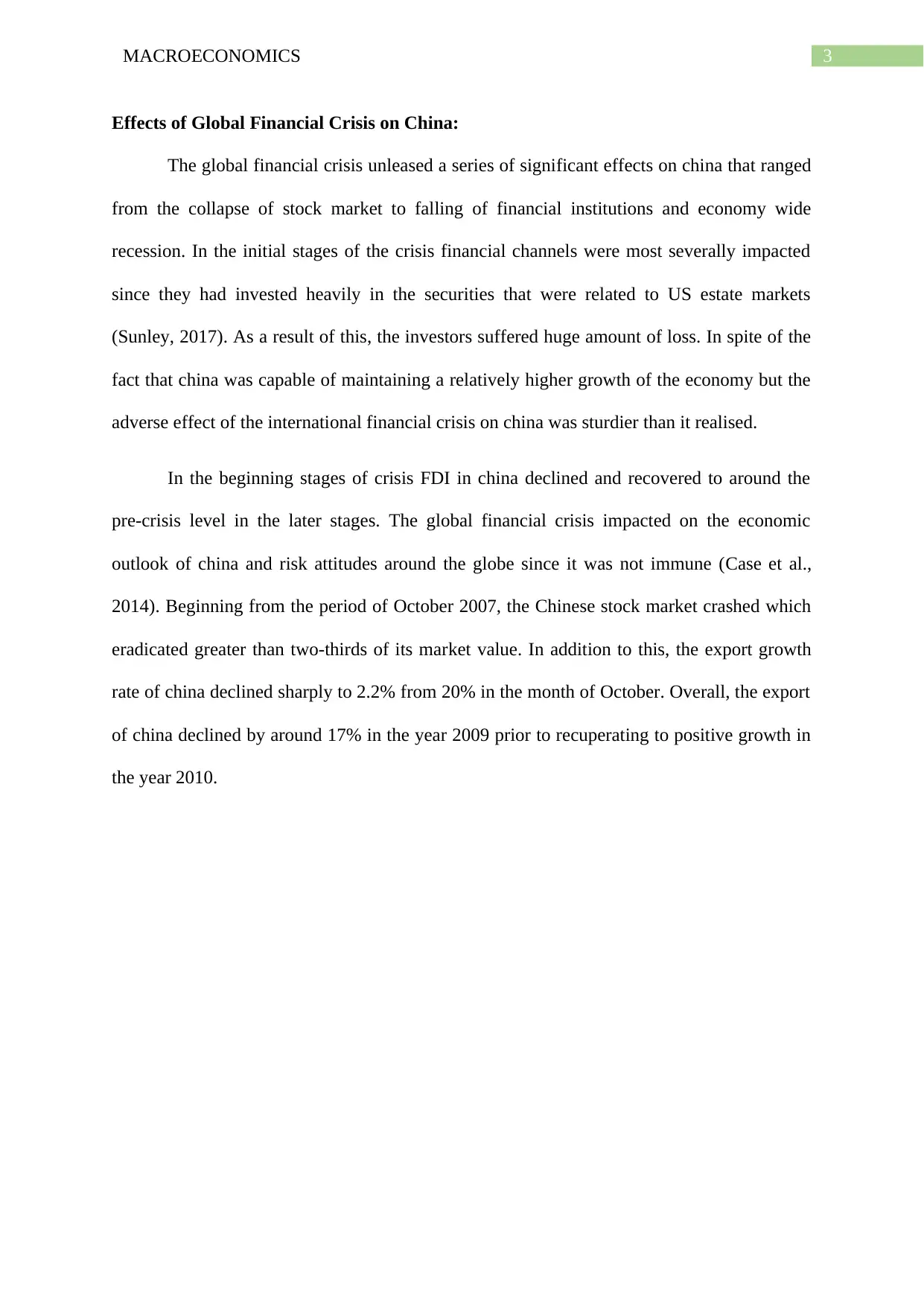
3MACROECONOMICS
Effects of Global Financial Crisis on China:
The global financial crisis unleased a series of significant effects on china that ranged
from the collapse of stock market to falling of financial institutions and economy wide
recession. In the initial stages of the crisis financial channels were most severally impacted
since they had invested heavily in the securities that were related to US estate markets
(Sunley, 2017). As a result of this, the investors suffered huge amount of loss. In spite of the
fact that china was capable of maintaining a relatively higher growth of the economy but the
adverse effect of the international financial crisis on china was sturdier than it realised.
In the beginning stages of crisis FDI in china declined and recovered to around the
pre-crisis level in the later stages. The global financial crisis impacted on the economic
outlook of china and risk attitudes around the globe since it was not immune (Case et al.,
2014). Beginning from the period of October 2007, the Chinese stock market crashed which
eradicated greater than two-thirds of its market value. In addition to this, the export growth
rate of china declined sharply to 2.2% from 20% in the month of October. Overall, the export
of china declined by around 17% in the year 2009 prior to recuperating to positive growth in
the year 2010.
Effects of Global Financial Crisis on China:
The global financial crisis unleased a series of significant effects on china that ranged
from the collapse of stock market to falling of financial institutions and economy wide
recession. In the initial stages of the crisis financial channels were most severally impacted
since they had invested heavily in the securities that were related to US estate markets
(Sunley, 2017). As a result of this, the investors suffered huge amount of loss. In spite of the
fact that china was capable of maintaining a relatively higher growth of the economy but the
adverse effect of the international financial crisis on china was sturdier than it realised.
In the beginning stages of crisis FDI in china declined and recovered to around the
pre-crisis level in the later stages. The global financial crisis impacted on the economic
outlook of china and risk attitudes around the globe since it was not immune (Case et al.,
2014). Beginning from the period of October 2007, the Chinese stock market crashed which
eradicated greater than two-thirds of its market value. In addition to this, the export growth
rate of china declined sharply to 2.2% from 20% in the month of October. Overall, the export
of china declined by around 17% in the year 2009 prior to recuperating to positive growth in
the year 2010.
Paraphrase This Document
Need a fresh take? Get an instant paraphrase of this document with our AI Paraphraser
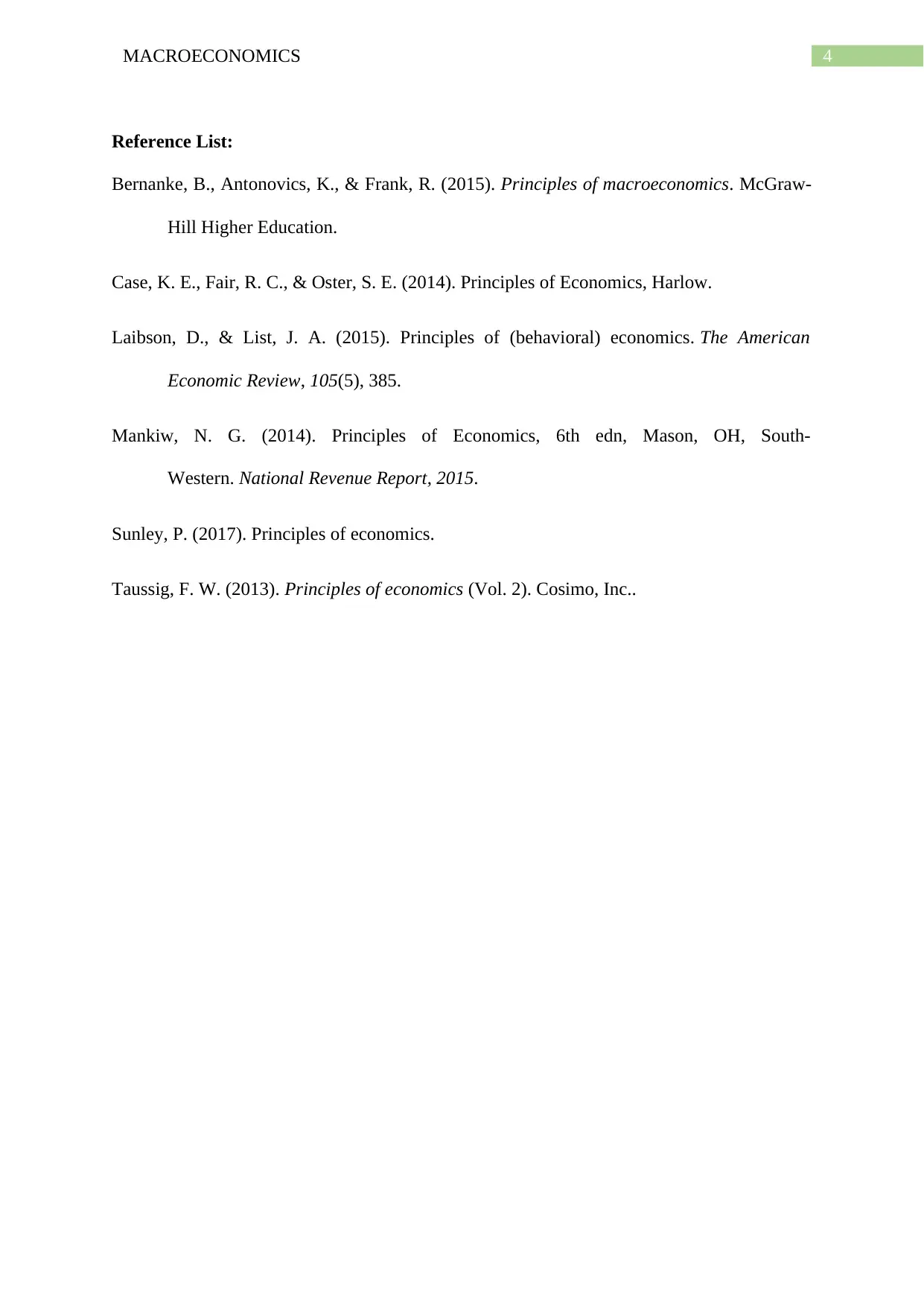
4MACROECONOMICS
Reference List:
Bernanke, B., Antonovics, K., & Frank, R. (2015). Principles of macroeconomics. McGraw-
Hill Higher Education.
Case, K. E., Fair, R. C., & Oster, S. E. (2014). Principles of Economics, Harlow.
Laibson, D., & List, J. A. (2015). Principles of (behavioral) economics. The American
Economic Review, 105(5), 385.
Mankiw, N. G. (2014). Principles of Economics, 6th edn, Mason, OH, South-
Western. National Revenue Report, 2015.
Sunley, P. (2017). Principles of economics.
Taussig, F. W. (2013). Principles of economics (Vol. 2). Cosimo, Inc..
Reference List:
Bernanke, B., Antonovics, K., & Frank, R. (2015). Principles of macroeconomics. McGraw-
Hill Higher Education.
Case, K. E., Fair, R. C., & Oster, S. E. (2014). Principles of Economics, Harlow.
Laibson, D., & List, J. A. (2015). Principles of (behavioral) economics. The American
Economic Review, 105(5), 385.
Mankiw, N. G. (2014). Principles of Economics, 6th edn, Mason, OH, South-
Western. National Revenue Report, 2015.
Sunley, P. (2017). Principles of economics.
Taussig, F. W. (2013). Principles of economics (Vol. 2). Cosimo, Inc..
1 out of 5
Related Documents
Your All-in-One AI-Powered Toolkit for Academic Success.
+13062052269
info@desklib.com
Available 24*7 on WhatsApp / Email
![[object Object]](/_next/static/media/star-bottom.7253800d.svg)
Unlock your academic potential
Copyright © 2020–2025 A2Z Services. All Rights Reserved. Developed and managed by ZUCOL.





